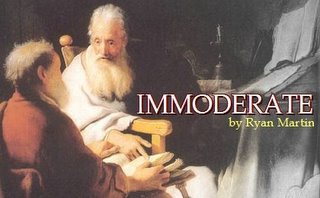A Difficult Christmas text: Matthew 2:15 citing Hosea 11:1 (Part 4)
This will conclude the series of articles I have been posting on Matthew's use of Hosea 11:1, where Jesus' coming out of Egypt as a fulfillment of this prophecy. We are concerned here with Matthew 2:14-15, 'And he rose and took the child and his mother by night and departed to Egypt and remained there until the death of Herod. This was to fulfill what the Lord had spoken by the prophet, "Out of Egypt I called my son."' I began by introducing the problem. Then we looked at Calvin's interpretation of the passage and the sensus plenior view. The third part looked at two more views: Gundry's interpretation of typology emphasizing sonship and the view that this passage is typological fulfilled. Today I will offer what I believe to the correct interpretation and some concluding remarks.
Sensus Literalis
This view, which was proposed by John Sailhammer,1 begins with a proper understanding of Hosea–that his prophecies of judgment in chapters 4-14 are to be understood within the lens of 3:5, "Afterward the children of Israel shall return and seek the LORD their God, and David their king, and they shall come in fear to the LORD and to his goodness in the latter days" (ESV).2 Sailhammer thereupon deduces that,
Hosea intimately knew the Pentateuch, which was natural for prophets of his day.5 He doubtless observed the Pentateuch had its own eschatological interpretation of the exodus event, and, when Hosea drew from the Pentateuch’s language in referencing the exodus, particularly with this phrase, it is likely that he too was thinking of the future.6 The phrase Hosea uses is strikingly similar to Num 24:8, which says “God will bring him [this Messiah] out of Egypt,” which, in turn, closely echos the words in 23:22, “God brought them out of Egypt.” Sailhammer observes,
Therefore, it is highly probable, particularly from Hosea’s word choice in 11:1, that the prophecy of Numbers 24:8 was to a great degree in his mind as he too looked to the future of God’s deliverance.8 Matthew would have likewise noticed this, and would have interpreted Hosea’s remark to be wholly prophetic. “[Matthew] was . . . drawing on the sensus literalis from the book of Hosea9.”
Conclusion
Given the understanding Hosea had for the messianic significance of the exodus, and the prophecies made from it by Balaam in Numbers 24, I tentatively conclude that it is best to understand Matthew as using “Out of Egypt I have called my Son” in the same sense that Hosea did: futuristically. This view best accounts for the fulfillment language with which Matthew introduces the statement. Jesus was brought of Egypt, just as it was prophesied regarding him in Numbers 24, and later in Hosea 11:1.
____________
1John Sailhammer, “Hosea 11:1 and Matthew 2:15" Westminster Theological Journal 63 (2001): 87-96.
2Sailhammer builds his case on Brevard Childs and his canonical interpretation of Hosea (Introduction to the Old Testament as Scripture [Philadelphia: Fortress, 1979]).
3Sailhammer, “Hosea 11:1,” 88-89.
4Both Num 24:3 and 15 say that Balaam “took up his parable.”
5Sailhammer convincingly demonstrates that Hosea had a very intimate knowledge with the Pentateuch (“Hosea 11:1,” 93-95).
6Ibid, 91.
7Ibid, 95.
8Another tie back to Num 24 is the correspondence of 24:3 and 15 that Balaam spoke in “parables” to Hos 12:1.
9Ibid, 96.
Sensus Literalis
This view, which was proposed by John Sailhammer,1 begins with a proper understanding of Hosea–that his prophecies of judgment in chapters 4-14 are to be understood within the lens of 3:5, "Afterward the children of Israel shall return and seek the LORD their God, and David their king, and they shall come in fear to the LORD and to his goodness in the latter days" (ESV).2 Sailhammer thereupon deduces that,
Hos 11:1 speaks of the future, not the past. The book, in fact, provides its own clue to the meaning of 11:1 in verse 11:5, “[Israel] will not return to Egypt, but Assyria will be their king because they have refused to repent.” In Hos 11:1-4, then, the historical exodus is understood as a metaphor. It is an image of future redemption. Egypt is Assyria, the enemy oppressor.3Hos 11:1, although propositional statement on the surface, resonates the prophecy of messianic deliverance which is made by the Pentateuch’s own interpretation of the exodus. Hosea says in 12:10 that God speaks through his prophets by means of parables or “similitudes,” and this phrase itself rehearses the words of Balaam as he interpreted the Exodus event messianicly in Num 24.4 So how does Hosea speak of the future in his retrospective statement “Out of Egypt I have called my Son?”
Hosea intimately knew the Pentateuch, which was natural for prophets of his day.5 He doubtless observed the Pentateuch had its own eschatological interpretation of the exodus event, and, when Hosea drew from the Pentateuch’s language in referencing the exodus, particularly with this phrase, it is likely that he too was thinking of the future.6 The phrase Hosea uses is strikingly similar to Num 24:8, which says “God will bring him [this Messiah] out of Egypt,” which, in turn, closely echos the words in 23:22, “God brought them out of Egypt.” Sailhammer observes,
Balaam looked back at the exodus as the grounds for God’s future salvation of his people Israel. In . . . Num 24, Balaam viewed the coming of a future “king” as a new exodus–“God will bring him up from Egypt.” The later vision, Num 24, is patterned after the earlier, Num 23. . . . The past exodus is presented as a picture of the exodus of the future.7
Therefore, it is highly probable, particularly from Hosea’s word choice in 11:1, that the prophecy of Numbers 24:8 was to a great degree in his mind as he too looked to the future of God’s deliverance.8 Matthew would have likewise noticed this, and would have interpreted Hosea’s remark to be wholly prophetic. “[Matthew] was . . . drawing on the sensus literalis from the book of Hosea9.”
Conclusion
Given the understanding Hosea had for the messianic significance of the exodus, and the prophecies made from it by Balaam in Numbers 24, I tentatively conclude that it is best to understand Matthew as using “Out of Egypt I have called my Son” in the same sense that Hosea did: futuristically. This view best accounts for the fulfillment language with which Matthew introduces the statement. Jesus was brought of Egypt, just as it was prophesied regarding him in Numbers 24, and later in Hosea 11:1.
____________
1John Sailhammer, “Hosea 11:1 and Matthew 2:15" Westminster Theological Journal 63 (2001): 87-96.
2Sailhammer builds his case on Brevard Childs and his canonical interpretation of Hosea (Introduction to the Old Testament as Scripture [Philadelphia: Fortress, 1979]).
3Sailhammer, “Hosea 11:1,” 88-89.
4Both Num 24:3 and 15 say that Balaam “took up his parable.”
5Sailhammer convincingly demonstrates that Hosea had a very intimate knowledge with the Pentateuch (“Hosea 11:1,” 93-95).
6Ibid, 91.
7Ibid, 95.
8Another tie back to Num 24 is the correspondence of 24:3 and 15 that Balaam spoke in “parables” to Hos 12:1.
9Ibid, 96.







3 Comments:
Why not simply say that this is analogical? In Hosea 11:1, Matthew saw an analogous situation to what was happpening in the life of Christ.
It is clear that Hosea 11:1 is a historical statement, and vv. 2ff rule out any possibility of Messianic intent in Hosea's mind. Contextually, whatever v. 1 is talking about is the same person/people that vv. 2ff are talking about. Therefore, it cannot be Christ.
Pleroo has a wide range of meaning that does not require actual prophetic fulfillment. (How do you fulfill a historical statement anyway??).
It seems to me that Matt 2:15 has an equivalent in our modern usage of "Waterloo." Often, when someone encounters great defeat, snatching defear from teh jaws of victory, we say, "That was their Waterloo." It is a historical statement that virtually all recognize. No one thinks that Waterloo was a prophecy. It was a historical event.
In the same way, Matthew uses a "This is like what happened ..." to make his point. To me, the pursuit of sensus plenior has always involved a lot more textual and exegetical gymnastics than I am comfortable participating in. It seems easier just to read the context, and pretend like they use language the same way we do. After all, they did ...
Larry, is there a difference between what you call analogous and typological view? I have sympathy towards the typological view.
I am aware of the problems with the word pleroo.
Just to demonstrate the difficulties with your response, to which I am sympathetic, let me point out that you have to change "this was to fulfill what the Lord had spoken by the prophet" to "this is like what happened." It seems that Matthew is using this theme of "fulfillment" in an apologetic way. So would you, were you a first century Jew, have embraced this as a fulfillment of prophecy? That is part of the problem. And there are many more issues.
One mnore note. You must mean "sensus literalis" not "sensus plenior" in that last paragraph. Sensus plenior seems to require hermeneutical and philosophical "gymnastics," while sensus literalis seems to require the "textual and exegetical gymnastics" of which you speak. But I like you use of the word "pretend." It illustrates the complexity of the problem well . . .
For some, there is not much difference between typological and analogical. I see a difference because I think types are limited to what the NT defines as types. So I see a lot fewer "types" than most other do.
YOu said that I have to change "this is to fulfill" to "this is what happened." My point about pleroo is that "this is what happened" is within the semantic domain and context tells us which meaning to understand. So I don't really see it as "changing" but rather understanding what Matthew intended.
I don't see how Matthew could have intended us to understand this as a "fulfillment" like we generally think of. The text in question (Hos 11) wasn't a prophecy to be fulfilled. I don't think first century Jews would have embraced this as a "fulfillment" of a non-prophecy, but perhaps that is convenient for me.
Post a Comment
<< Home